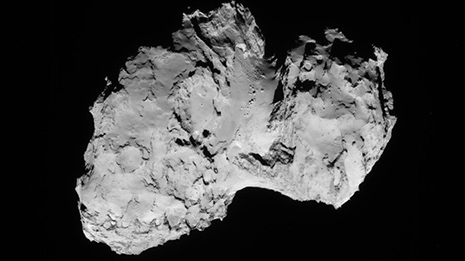The comet 67P/Churyumov-Gerasimenko – or Chury for short – is traveling through space some 400 million km (about 250 million miles) from the sun, but this chunk of ice has already started releasing gas molecules. They were detected by the Rosetta orbiter sensor for ion and neutral analysis (ROSINA) – first in August - but this time an unexpectedly much richer picture was revealed.
“The perfume of 67P/C-G is quite strong, with the odor of rotten eggs (hydrogen sulfide), horse stable (ammonia), and the pungent, suffocating odor of formaldehyde. This is mixed with the faint, bitter, almond-like aroma of hydrogen cyanide,” Kathrin Altwegg, head of the ROSINA project at the Center for Space and Habitability (CSH) at the University of Bern, described the smell. “Add some whiff of alcohol (methanol) to this mixture, paired with the vinegar-like aroma of sulfur dioxide and a hint of the sweet aromatic scent of carbon disulfide, and you arrive at the ‘perfume’ of our comet“.
“What’s surprising is we already have extremely rich chemistry at this distance from the sun,” she added.
To catch up with 67P/Churyumov-Gerasimenko, Rosetta has made a 10-year-long journey, which involved three flybys of Earth and one of Mars. The Rosetta spacecraft has been orbiting the comet since September.
On November 12 at around 09:35 GMT, Rosetta will release its landing probe, Philae – the first manmade object to land on a comet. The historic touchdown is expected to happen seven hours later, and in two hours’ time the first pictures from the surface will be received by scientists at the European Space Agency ESA, as well as two lander control centers in Germany and France.
According to ESA astronomers, the gases composing the comet alongside with frozen water and carbon dioxide could open the door to the exploration of the origins of comets, as well as of the solar system. It could also provide with some insight into the differences between the comets coming from the ‘Jupiter family’ and from the Oort cloud on the outskirts of our solar system.
Belonging to the Jupiter family, 67P/C-G is a periodic comet with a well-known and predictable orbit of 6.5 years. Discovered in 1969 by Soviet scientists, it will approach the sun at its closest in August, 2015.
Comets are icy bodies that are regarded as fossils from the times when the solar system was originating, and they could provide scientists with some of the primordial material. That is why comets coming from the distant Oort cloud, rare guests to the inner solar system and therefore ‘untouched’ by the sun, such as the comet Siding Spring are pristine presents for scientists eager to learn more about the original materials that formed the solar system 4.6 billion years ago.
More about:
















































